Themed collection The environmental geochemistry and biology of hydraulic fracturing

Front cover
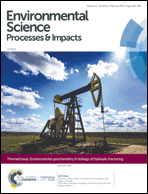
Back cover
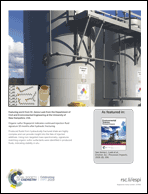
Contents list
More than a decade of hydraulic fracturing and horizontal drilling research
Guest editors Desiree Plata, Rob Jackson, Avner Vengosh and Paula Mouser introduce “The environmental geochemistry and biology of hydraulic fracturing” themed issue of Environmental Science: Processes & Impacts.

Environ. Sci.: Processes Impacts, 2019,21, 193-194
https://doi.org/10.1039/C9EM90004G
In situ transformation of hydraulic fracturing surfactants from well injection to produced water
Chemical changes to hydraulic fracturing fluids within fractured unconventional reservoirs may affect hydrocarbon recovery and, in turn, the environmental impact of unconventional oil and gas development.
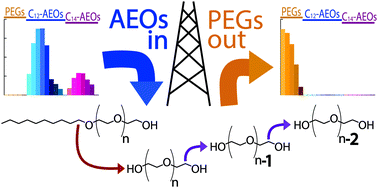
Environ. Sci.: Processes Impacts, 2019,21, 1777-1786
https://doi.org/10.1039/C9EM00153K
Effect of maturity and mineralogy on fluid-rock reactions in the Marcellus Shale
Maturity and mineralogy of shale significantly controls dissolution/precipitation reactions and release of organic contaminants during hydraulic fracturing.
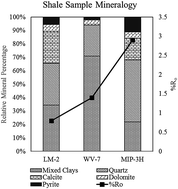
Environ. Sci.: Processes Impacts, 2019,21, 845-855
https://doi.org/10.1039/C8EM00452H
Microbial lipid biomarkers detected in deep subsurface black shales
Evidence for microbes has been detected in extreme subsurface environments as deep as 2.5 km with temperatures as high as 90 °C, demonstrating that microbes can adapt and survive extreme environmental conditions.

Environ. Sci.: Processes Impacts, 2019,21, 291-307
https://doi.org/10.1039/C8EM00444G
Assessing changes in groundwater chemistry in landscapes with more than 100 years of oil and gas development
Historical oil & gas development or using salt and production brines on roads for de-icing or dust abatement might impact groundwater chemistry.
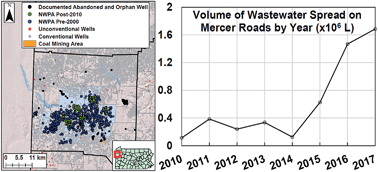
Environ. Sci.: Processes Impacts, 2019,21, 384-396
https://doi.org/10.1039/C8EM00385H
Characterization and implications of solids associated with hydraulic fracturing flowback and produced water from the Duvernay Formation, Alberta, Canada
Identifying the solids in flowback and produced water will improve treatment and reduce environmental risks.
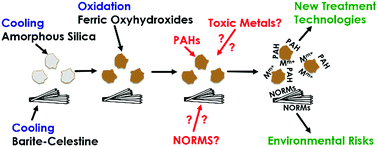
Environ. Sci.: Processes Impacts, 2019,21, 242-255
https://doi.org/10.1039/C8EM00404H
Flowback verses first-flush: new information on the geochemistry of produced water from mandatory reporting
Unconventional oil and gas development uses the subsurface injection of large amounts of a variety of industrial chemicals, and there are concerns about the return of these chemical to the surface with water produced with oil and gas from stimulated wells.
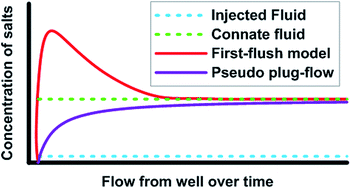
Environ. Sci.: Processes Impacts, 2019,21, 370-383
https://doi.org/10.1039/C8EM00351C
Emerging investigator series: radium accumulation in carbonate river sediments at oil and gas produced water discharges: implications for beneficial use as disposal management
In the western U.S., produced water from oil and gas wells discharged to surface water augments downstream supplies used for irrigation and livestock watering.
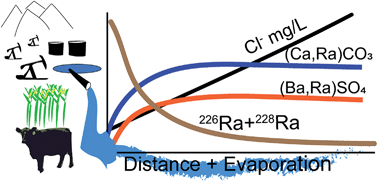
Environ. Sci.: Processes Impacts, 2019,21, 324-338
https://doi.org/10.1039/C8EM00336J
Radium in hydraulic fracturing wastewater: distribution in suspended solids and implications to its treatment by sulfate co-precipitation
More than half of Ra-226 in waste solid is labile, which can be immobilized by AMD with proper chemistry.
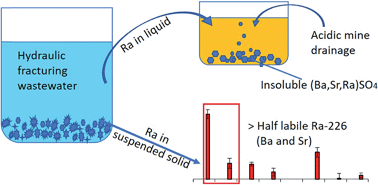
Environ. Sci.: Processes Impacts, 2019,21, 339-351
https://doi.org/10.1039/C8EM00311D
Accuracy of methods for reporting inorganic element concentrations and radioactivity in oil and gas wastewaters from the Appalachian Basin, U.S. based on an inter-laboratory comparison
Results from this inter-laboratory comparison indicate that O&G waste analyses can be inaccurate and imprecise.
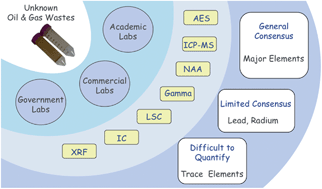
Environ. Sci.: Processes Impacts, 2019,21, 224-241
https://doi.org/10.1039/C8EM00359A
Characterization and biological removal of organic compounds from hydraulic fracturing produced water
Hydraulic fracturing generates large volumes of produced water, and treatment of produced water may be necessary for disposal or reuse.
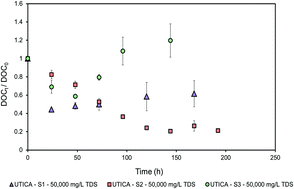
Environ. Sci.: Processes Impacts, 2019,21, 279-290
https://doi.org/10.1039/C8EM00354H
Analysis of bacteria stress responses to contaminants derived from shale energy extraction
In order to survive environmental changes, bacteria have stress responses, which protect them from adverse and variable conditions.
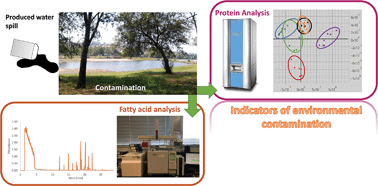
Environ. Sci.: Processes Impacts, 2019,21, 269-278
https://doi.org/10.1039/C8EM00338F
Raw material recovery from hydraulic fracturing residual solid waste with implications for sustainability and radioactive waste disposal
By applying a novel system to unconventional oil and gas residual waste, we were able to recover valuable raw materials, which could represent significant savings to disposal cost, while aiding radioactivity management.
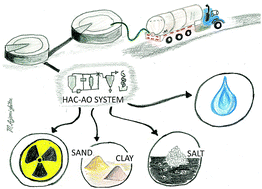
Environ. Sci.: Processes Impacts, 2019,21, 308-323
https://doi.org/10.1039/C8EM00248G
Identifying groundwater compartmentalisation for hydraulic fracturing risk assessments
Groundwater quality and seismic reflection data are combined to identify compartmentalisation in the Bowland Basin, northwest England, thereby providing a method that could be applied to other prospective shale basins.

Environ. Sci.: Processes Impacts, 2019,21, 352-369
https://doi.org/10.1039/C8EM00300A
Lab-simulated downhole leaching of formaldehyde from proppants by high performance liquid chromatography (HPLC), headspace gas chromatography-vacuum ultraviolet (HS-GC-VUV) spectroscopy, and headspace gas chromatography-mass spectrometry (HS-GC-MS)
Different methods to analyze formaldehyde from proppants was investigated under lab-simulated downhole conditions.
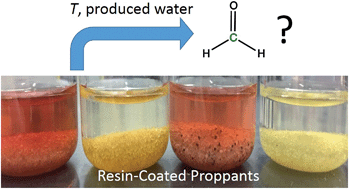
Environ. Sci.: Processes Impacts, 2019,21, 214-223
https://doi.org/10.1039/C8EM00342D
Organic sulfur fingerprint indicates continued injection fluid signature 10 months after hydraulic fracturing
Ultrahigh resolution mass spectrometry used to identify unique organic sulfur signatures in hydraulic fracturing wastewaters likely associated with alcohol ethoxysulfate surfactants.
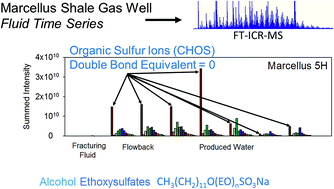
Environ. Sci.: Processes Impacts, 2019,21, 206-213
https://doi.org/10.1039/C8EM00331A
Degradation of polyethylene glycols and polypropylene glycols in microcosms simulating a spill of produced water in shallow groundwater
Polyethylene glycol, polypropylene glycol, and their degradation products could be utilized to better characterize shallow groundwater contamination following a spill of produced water.
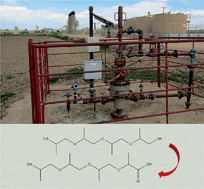
Environ. Sci.: Processes Impacts, 2019,21, 256-268
https://doi.org/10.1039/C8EM00291F
Exploring matrix effects and quantifying organic additives in hydraulic fracturing associated fluids using liquid chromatography electrospray ionization mass spectrometry
Liquid chromatography electrospray ionization mass spectrometry was used to quantify chemical additives in water collected from unconventional shale gas wells.

Environ. Sci.: Processes Impacts, 2019,21, 195-205
https://doi.org/10.1039/C8EM00135A
About this collection
Horizontal Drilling with Hydraulic Fracturing (HDHF) has enabled rapid increases in oil and gas supplies, with these technologies now being applied for hydrocarbon development in shale basins across the globe. Concerns regarding the environmental impacts of HDHF technologies have spawned new research over the past 10 years. This Themed Issue, Guest Edited by ESPI Reviews Editor Desirée Plata (MIT), Rob Jackson (Stanford University), Paula Mouser (University of New Hampshire) and Avner Vengosh (Duke University) showcases work which reports state-of-the-art knowledge across a broad range of chemical classes (e.g., methane, light, and noble gases, hydrophilic and hydrophobic organic compounds, inorganic chemicals, isotope tracers, radioactive elements, and heavy or rare earth metals) and disciplines (e.g., environmental microbiology, geochemistry and biogeochemistry, fluid dynamics and hydrology, as well as public health and policy considerations) that integrate new research findings in environmental processes. We hope you enjoy reading the papers in this collection
Also of interest
Edited by Ron Hester and Roy Harrison
This volume examines the technology of fracking in detail, as well as the associated economic, societal and global climate change considerations. Anyone wishing to gain a balanced view of hydraulic fracturing will benefit from reading this book, which is aimed at researchers in academia and industry, policy makers, environmental science students and the interested layman.